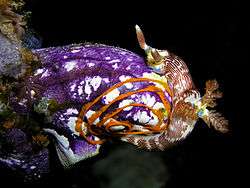Polycarpa aurata
| Polycarpa aurata | |
|---|---|
 | |
| Polycarpa aurata, purple and yellow variant | |
 | |
| Nudibranch (Nembrotha lineolata) laying an egg spiral on a Polycarpa aurata off the coast of Metinaro, East Timor. | |
| Scientific classification | |
| Kingdom: | Animalia |
| Phylum: | Chordata |
| Subphylum: | Tunicata |
| Class: | Ascidiacea |
| Order: | Stolidobranchia |
| Family: | Styelidae |
| Genus: | Polycarpa |
| Species: | P. aurata |
| Binomial name | |
| Polycarpa aurata (Quoy & Gaimard, 1834)[1] | |
| Synonyms[1] | |
| |
Polycarpa aurata, also known as the ox heart ascidian, the gold-mouth sea squirt or the ink-spot sea squirt, is a species of tunicate in the family Styelidae.
Description
Polycarpa aurata grows to a height of 5 to 15 cm (2 to 6 in). It has an urn-shaped, hollow body with two siphons, one at the top and the other on the side. The body colour of this tunicate is white with purple and orange patches and purple lines. The inside is yellow or orange and this is visible around the rim of the siphons.[2][3]
Distribution
This species is found in the tropical eastern Indian Ocean and the western Pacific Ocean. Its range includes the Philippines, Indonesia and northern Australia. Its depth range is 5 to 50 m (16 to 164 ft).[2]
Biology
Tunicates feed by drawing water in through the branchial siphon at the top, filtering out phytoplankton, bacteria and other food particles, before expelling the water through the atrial siphon at the side. Sometimes hydroids and algae grow on the outside of the tunicate[2] and nudibranchs such as Nembrotha lineolata sometimes feed on it.[4]
References
- 1 2 Karen Sanamyan (2012). Noa Shenkar, Arjan Gittenberger, Gretchen Lambert, Marc Rius, Rosana Moreira Da Rocha, Billie J Swalla & Xavier Turon, eds. "Polycarpa aurata". Ascidiacea World Database. World Register of Marine Species. Retrieved May 24, 2012.
- 1 2 3 "Polycarpa aurata" (in French). Sous les Mers. Retrieved January 12, 2015.
- ↑ Polycarpa aurata. Komodo National Park, Indonesia.
- ↑ Rudman, W. B. "Nembrotha lineolata Bergh, 1905". Sea Slug Forum. Australian Museum. Retrieved January 12, 2015.
External links
 Media related to Polycarpa aurata at Wikimedia Commons
Media related to Polycarpa aurata at Wikimedia Commons- Image
- Image